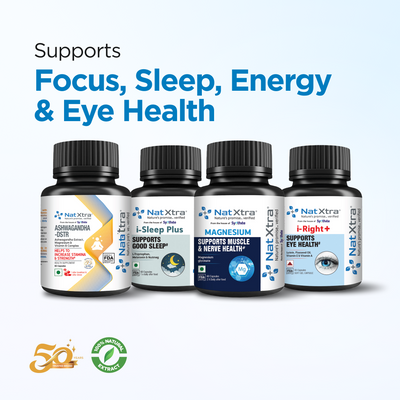Screen Fatigue Protecting Your Eyes in a Digital World
Introduction to Screen Fatigue
In our increasingly digital world, screen usage has become a regular part of life, whether for work, entertainment, or social interaction. However, prolonged exposure to screens can lead to Digital Eye Strain (DES), also known as computer vision syndrome. Symptoms such as headaches, dry eyes, blurred vision, and neck pain are common among people who spend long hours in front of digital devices. As remote work, online learning, and constant media consumption increase, more individuals are experiencing the adverse effects of excessive screen time. Understanding the causes and symptoms of DES is essential to take the necessary steps to mitigate its impact. This blog aims to highlight the importance of eye care, provide practical tips, and suggest solutions like supplementation to help combat the growing issue of screen fatigue.
What is Digital Eye Strain?
Digital Eye Strain (DES) refers to the discomfort and visual disturbances caused by prolonged use of digital devices such as computers, smartphones, tablets, and e-readers. When we focus on screens for extended periods, our eye muscles become strained due to constant near-focusing, leading to fatigue. Additionally, the blue light emitted by screens has been shown to contribute to discomfort and may interfere with our sleep patterns. DES can cause a wide range of symptoms, including eye irritation, difficulty focusing, and headaches. As digital device use continues to rise, understanding DES is critical to maintaining long-term eye health and preventing more serious issues such as digital retinal damage.

Symptoms of Digital Eye Strain
Identifying the symptoms of Digital Eye Strain (DES) early on can help individuals take proactive steps to relieve discomfort and prevent long- term damage. Common symptoms include:
- Dry or Irritated Eyes: Prolonged screen time reduces the natural blinking rate, causing eyes to dry out.
- Blurred or Double Vision: Staring at a screen for too long without a break can cause temporary difficulty focusing.
- Headaches: Straining to focus on a screen can result in tension headaches, often at the temples or behind the eyes.
- Neck and Shoulder Pain: Poor posture while using screens can lead to musculoskeletal discomfort.
- Eye Fatigue: After extended screen use, eyes may feel heavy or tired, affecting concentration and productivity.
- Recognizing these symptoms early can prevent further strain and improve overall well-being by making simple adjustments to screen habits, posture, and lighting.
Causes of Digital Eye Strain
Several factors contribute to the development of Digital Eye Strain (DES), making it a widespread issue in the modern, screen-heavy environment.
- Prolonged Screen Time: The primary cause of DES is spending extended hours staring at screens, causing the eyes to work harder than usual.
- Blue Light Exposure: Digital screens emit high-energy blue light that can contribute to eye fatigue and disrupt sleep by interfering with the production of melatonin, a hormone responsible for regulating sleep.
- Reduced Blinking: When using screens, people tend to blink less, which leads to dryness and discomfort. Blinking helps to spread moisture over the surface of the eye, and reduced blinking increases the risk of irritation.
- Improper Lighting and Glare: Poor room lighting, glare from windows, or reflective light from the screen can further increase the strain on the eyes.
- Unoptimized Screen Settings: Small font sizes, high contrast, and bright screens can make it more difficult to read and lead to unnecessary strain. Addressing these causes through screen settings adjustments, regular breaks, and proper lighting can help mitigate the effects of DES.
Preventive Measures for DES

Preventing Digital Eye Strain requires a combination of lifestyle changes and better screen habits.
- Follow the 20-20-20 Rule: Every 20 minutes, take a 20-second break and look at something 20 feet away. This simple habit allows the eye muscles to relax and reduces strain.
- Adjust Your Screen Settings: Modify the brightness, contrast, and font size to reduce glare and improve readability. Most digital devices have settings to adjust the color temperature of the screen, which can help reduce the amount of blue light emitted.
- Proper Lighting: Ensure that your workspace is well-lit, and avoid glare from windows or overhead lights. Using adjustable task lighting can minimize eye strain caused by harsh lighting.
- Take Regular Breaks: In addition to the 20-20-20 rule, make a conscious effort to take breaks every 30 minutes to stretch and rest your eyes.
- Position Your Screen Properly: Ensure that your screen is positioned at eye level to minimize neck and shoulder strain, and maintain proper posture while using digital devices.
- These habits, though simple, can significantly reduce the risk of developing Digital Eye Strain and protect long-term eye health.
The Role of Nutrition in Eye Health
Nutrition plays a crucial role in maintaining healthy vision and supporting the eyes in their battle against Digital Eye Strain (DES). The right nutrients can strengthen the eye muscles, protect against oxidative damage, and support overall eye function. Key nutrients include:
- Lutein and Zeaxanthin: These powerful antioxidants filter blue light and protect the retina from damage. They are found in foods like leafy greens, egg yolks, and corn.
- Omega-3 Fatty Acids: These healthy fats help maintain tear production and prevent dry eyes. Omega-3s are found in fatty fish, walnuts, and flaxseeds.
- Vitamin A: Essential for maintaining proper vision and keeping the eyes moist, Vitamin A is found in foods like carrots, sweet potatoes, and leafy greens.
- Vitamin C and E: Both vitamins have antioxidant properties that protect the eyes from oxidative damage caused by blue light and environmental pollutants.
- However, it can be challenging to get all the necessary nutrients from a diet alone, especially for people with busy lifestyles or poor eating habits. Supplementation can provide an effective way to meet nutritional needs and support eye health.
Supplement Support: Natxtra i-Right
While adopting healthy screen habits and consuming eye-friendly foods is crucial, supplementation can offer additional support to protect your eyes from the damaging effects of prolonged screen use. Natxtra i-Right is an ideal supplement to help combat Digital Eye Strain and support overall eye health. Each i-Right capsule contains:
- Lutein: Known for its ability to filter blue light and protect the retina, lutein helps improve visual clarity and reduces discomfort caused by excessive screen time.
- Flaxseed Oil: Rich in omega-3 fatty acids, flaxseed oil supports tear production, reducing dryness and irritation.
- Vitamin A: Essential for maintaining healthy vision, Vitamin A helps the eyes stay moist and function properly.
- Vitamin E: This powerful antioxidant helps protect the eyes from oxidative damage caused by blue light and environmental stressors.
- By adding i-Right to your daily routine, you can provide your eyes with the essential nutrients they need to stay healthy and resilient in a digital world, helping to prevent or alleviate symptoms of Digital Eye Strain.

Digital Eye Strain is a growing concern as screen time continues to increase in our digital-driven world. However, by recognizing the symptoms early, adopting preventive measures, and incorporating a healthy diet and supplementation, we can protect our eyes from the harmful effects of prolonged screen exposure. Simple adjustments like following the 20-20-20 rule, optimizing screen settings, and taking regular breaks can make a significant difference in reducing eye strain. Furthermore, supplements like Natxtra i-Right, which is enriched with lutein, flaxseed oil, and essential vitamins, can provide targeted support to enhance eye health and comfort. Protect your eyes today—make small changes in your habits, prioritize nutrition, and take proactive steps to maintain your eye health in the digital age.
















